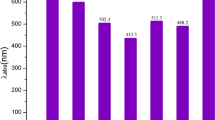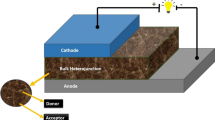Abstract
Context
The work described in this section uses DFT/TD-DFT/B3LYP/6-31G (d,p) (density functional theory and time-dependent density functional theory) to study and simulate the structural, optoelectronic, and optical properties of a series of conjugated compounds based on a modular D-A-Di-A-D architecture. These compounds integrate the D donor unit (carbazole), the A acceptor unit (benzothiadiazole) and various Di donor units. Using AMPS-1D (analysis of micronic structure and photonics), work has been carried out to evaluate the photovoltaic performance of these conjugated compounds in the context of organic solar cells. The compounds show variable performance in terms of energy conversion efficiency, ranging from 7.11 to 11.70%. The addition of a PEDOT layer between the active layer and the anode results in a significant improvement in photovoltaic performance, with energy conversion efficiencies of up to 15.31%, the highest value achieved. The use of ZnO as an intermediate layer remarkably improves photovoltaic performance for all compounds, with notable energy conversion efficiencies reaching 17.13%, 17.20%, and 18%. All in all, the compounds studied present promising prospects as viable candidates for organic block heterojunction (BHJ) solar cell applications.
Methods
DFT/TD-DFT/B3LYP/6-31G (d,p), these acronyms stand for the computational methods used to study the properties of compounds. DFT, for “Density Functional Theory”, is a quantum computation method used to describe the electronic and structural properties of molecular systems. TD-DFT, for “Time-Dependent Density Functional Theory”, is an extension of DFT that allows the treatment of optical and excitation properties. B3LYP is a density functional frequently used in DFT to calculate molecular properties. In addition, 6-31G (d,p) refers to a basic wave function used to approximate the distribution of electrons in molecules. AMPS-1D, or “Analysis of Micro and Photonic Structure”, is a modeling tool for studying the photovoltaic properties of multilayer structures, particularly in the context of organic solar cells.










Similar content being viewed by others
Data availability
Data will be available on reasonable request.
References
Al-Azzawi AGS, Aziz SB, Dannoun EMA, Iraqi A, Nofal MM, Murad AR, Hussein A M (2023) A mini review on the development of conjugated polymers steps towards the commercialization of organic solar cells. Polymers 15:164. https://doi.org/10.3390/polym15010164
Hmammouchi R, Adad A, Bouachrine M, Lakhlifi T (2013) Organic materials based on pyrazine for photovoltaic devices Correlation structure/electronic properties. J Mater Environ Sci 4(5):752–761
El Karkri A, El Mhamedi I, El Malki Z (2022) Prediction and simulation of electrical and optical characteristics of an OLED based on P3BEdotBT3A organic material. E3S Web Conf, 336:00062. https://doi.org/10.1051/e3sconf/202233600062
He A, Qin Y, Dai W, Luo X (2018) Novel D-A type dyes based on BODIPY for solution processed organic polymer solar cells. Dye Pigment 162:671–679. https://doi.org/10.1016/j.dyepig.2018.10.068
Fichou D, Horowitz G (2001) Molecular and polymer semiconductors conductors and superconductors overview. Encyclopedia of Materials Sci Technol 5748–5757. https://doi.org/10.1016/B0-08-043152-6/01000-7
Son HJ, He F, Carsten B, Yu L (2011) Are we there yet? Design of better conjugated polymers for polymer solar cells. J Mater Chem 21(47):18934–18945. https://doi.org/10.1039/c1jm12388b
Mishra A, Bäuerle P (2012) Small molecule organic semiconductors on the move: promises for future solar energy technology. Angew Chem Int Ed 51(9):2020–2067. https://doi.org/10.1002/anie.201102326
Zhou H, Yang L, You W (2012) Rational design of high performance conjugated polymers for organic solar cells. Macromolecules 45(2):607–632. https://doi.org/10.1021/ma201648t
Raftani M, Abram T, Bennani N, Bouachrine M (2020) Theoretical study of new conjugated compounds with a low bandgap for bulk heterojunction solar cells: DFT and TD-DFT study. Results in Chemistry 2:100040. https://doi.org/10.1016/j.rechem.2020.100040
Taouali W, Casida ME, Darghouth AAM, Alimi K (2018) Theoretical design of new small molecules with a low band-gap for organic solar cell applications: DFT and TD-DFT study. Comput Mater Sci 150:54–61. https://doi.org/10.1016/j.commatsci.2018.03.038
Becke AD (1988) Density-functional exchange-energy approximation with correct asymptotic behavior. Phys Rev A 38(6):3098
Krishnan RBJS, Binkley JS, Seeger R, Pople JA (1980) Self-consistent molecular orbital methods. XX. A basis set for correlated wave functions. J Chem Physics 72(1):650–654. https://doi.org/10.1063/1.438955
Jin R, Zhang X, Xin J et al (2023) Molecular design of D–π–A–π–D small molecule donor materials with narrow energy gap for organic solar cells applications. J Mol Model 29:273. https://doi.org/10.1007/s00894-023-05680-8
Frish MJ, Trucks GW, Schlegel HB, Scuseria GE, Robb MA, Cheeseman JR, Paterson G (2009) Gaussian 09, revision A. 02. Gaussian Inc, Wallingford CT
Kurban M, Gündüz B, Göktaş F (2019) Experimental and theoretical studies of the structural, electronic and optical properties of BCzVB organic material. Optik 182:611–617. https://doi.org/10.1016/j.ijleo.2019.01.080
Kurban M, Gündüz B (2017) Physical and optical properties of DCJTB dye for OLED display applications: experimental and theoretical investigation. J Mol Struct 1137:403–411. https://doi.org/10.1016/j.molstruc.2017.02.064
Ait Aicha Y, Bouzzine SM, Fahim ZM, Zair T, Bouachrine M, Hamidi M (2014) Quantum chemical investigations study of the effect of electron donor units on the structural, electronic and optoelectronic properties of diarylthienopyrazine analogs. Comput Theor Chem 1036:22–30. https://doi.org/10.1016/j.comptc.2014.03.008
Bourass M, El Alamy A, Bouachrine M (2019) Structural and photophysical studies of triphenylamine-based nonlinear optical dyes: effects of π-linker moieties on the D-π-A structure. C R Chim 22(5):373–385. https://doi.org/10.1016/j.crci.2019.05.008
Yan L, Lu Y, Li X (2016) A density functional theory protocol for the calculation of redox potentials of copper complexes. Phys Chem Chem Phys 18(7):5529–5536. https://doi.org/10.1039/C5CP06638G
Mhamedi I EL, El Karkri A, El Malki Z (2022) Simulation of the performance of organic solar cells based on D1-BT-EDOT-BT-D2A/PCBM structures,. E3S Web Conf 336:00063. https://doi.org/10.1051/e3sconf/202233600063
Sahu H, Panda AN (2013) Computational study on the effect of substituents on the structural and electronic properties of thiophene–pyrrole-based π-conjugated oligomers. Macromolecules 46(3):844–855
El Mhamedi I, El Karkri A, EL Malki Z, Bouachrine M (2023) Theoretical study on new conjugated compounds of organic solar cell: DFT, TD-DFT and AMPS1D. Mor J Chem 11(4):1221–1235. https://doi.org/10.48317/IMIST.PRSM/morjchemv11i04.35467
Abram T, Zgou H, Bejjit L, Hamidi M, Bouachrine M (2014) Design of new small molecules based on thiophene and oxathiazole for bulk heterojunction solar cells a computational study. J Int J Adv Res Comput Commun Eng 4(3):742–750
Kacimi R, Abram T, Saidi W, Bejjit L, Bouachrine M (2019) New organic molecular based on bis-dipolar diphenylamino-endcappedoligo aryl fluorene application for organic solar cells. Materials Today: Proc 13:1178–1187. https://doi.org/10.1016/j.matpr.2019.04.086
Lazrak M, Toufik H, Bouzzine SM et al (2023) Theoretical analysis on D-π-A triphenylamine-based dyes for dye-sensitized solar cells: effect of π-bridges on the optoelectronic, and photovoltaic properties. J Mol Model 29:266. https://doi.org/10.1007/s00894-023-05660-y
EL Mhamedi I, EL Karkri A, EL Malki Z, Bouachrine M (2023) Simulation and analysis of electro-optical characteristics of organic compounds in organic light-emitting diodes (OLEDS). Int J Eng Sci Technol 7(3):8–22. https://doi.org/10.29121/ijoest.v7.i3.2023.496
El Alamy A, Bourass M, Amine A, Hamid M, Bouachrine M (2017) New organic dyes based on phenylenevinylene for solar cells: DFT and TD-DFT investigation. Karbala Int J Mod Sci 3(2):75–82. https://doi.org/10.1016/j.kijoms.2017.03.002
Raftani M, Abram T, Bennani N, Bouachrine M (2020) Theoretical study of new conjugated compounds with a low bandgap for bulk heterojunction solar cells DFT and TD-DFT study. Results Chem 2:100040. https://doi.org/10.1016/j.crci.2019.05.008
Hassan AU, Sumrra SH, Mustafa G et al (2023) Efficient and tunable enhancement of NLO performance for indaceno-based donor moiety in A-π-D-π-D-π-A type first DSSC design by end-capped acceptors. J Mol Model 29:4. https://doi.org/10.1007/s00894-022-05402-6
Fuks JI, Luo K, Sandoval ED, Maitra NT (2015) Time-resolved spectroscopy in time-dependent density functional theory: an exact condition. Phys Rev Lett 114:183002. https://doi.org/10.1103/PhysRevLett.114.183002
EL Malki Z, Bouachrine M, Serein-Spirau F, Sotiropoulos JM (2018) DFT and TD-DFT study on the structural, optoelectronic and photovoltaic properties of chemically modified donor-acceptor conjugated oligomers for organic solar cells. Int J Adv Res Comput Sci Software Eng 8(12):38–51
Author information
Authors and Affiliations
Contributions
Zakaria EL Malki and Mohammad Bouachrine wrote the first version of the manuscript, while Imane EL Mhamedi and Anass EL Karkri were responsible for the main content. In addition, Imane EL Mhamedi was responsible for creating the figures. The final manuscript was approved by all authors after thorough reading and revision.
Corresponding author
Ethics declarations
Competing interests
The authors declare no competing interests.
Additional information
Publisher's Note
Springer Nature remains neutral with regard to jurisdictional claims in published maps and institutional affiliations.
Rights and permissions
Springer Nature or its licensor (e.g. a society or other partner) holds exclusive rights to this article under a publishing agreement with the author(s) or other rightsholder(s); author self-archiving of the accepted manuscript version of this article is solely governed by the terms of such publishing agreement and applicable law.
About this article
Cite this article
EL Mhamedi, I., EL Malki, Z., EL Karkri, A. et al. Analysis molecular design of novel D-A-Di-A-D conjugated compounds for high-efficiency organic solar cells. J Mol Model 29, 324 (2023). https://doi.org/10.1007/s00894-023-05729-8
Received:
Accepted:
Published:
DOI: https://doi.org/10.1007/s00894-023-05729-8




